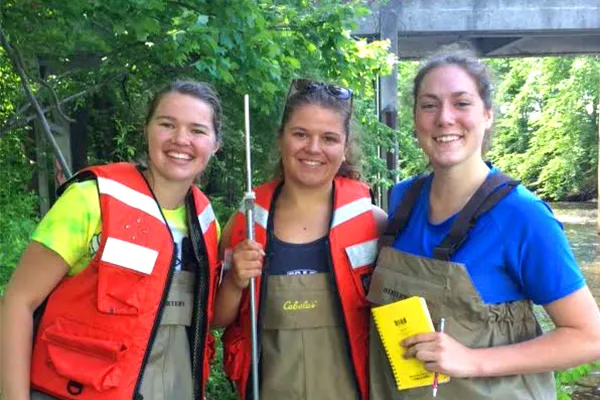Natural Flow: Students Test New Plan for Moving Sediment Out of Paradise Pond
Sustainability

Published June 29, 2016
What’s happening at Paradise Pond?
That’s a question campus community members may be asking in coming weeks after the pond is partially drained to allow for removal of sediment left behind by the Mill River.
The drawdown of the pond—which begins Wednesday, July 6, (weather permitting)—is part of an experiment that’s been in the works for the past two years. Students and faculty from geosciences, biological sciences and engineering—as well as staff from Facilities Management—have been exploring alternative ways to remove pond sediment without expensive dredging operations that can disrupt the pond and Mill River ecosystem.
The current plan is a sluicing technique that harnesses the natural power of stormwater to move unwanted sediment downstream. After the drawdown, a bulldozer will redistribute about 1,000 cubic yards of sediment to low spots in the pond. Some sediment will also be moved directly into the river channel just above the dam in hopes it will be carried downstream during high-flow conditions.
What are the chances the plan will work?
“I think there’s a lot of potential,” said geosciences major Sally Carttar ’18, as she stood on the shore of the pond with two other Smithies, preparing to measure water velocity after a recent rainfall. “It’s definitely worth trying.”
“Moving away from dredging is a move in the right direction,” chimed in Emma Harnisch ’18. “We want to achieve a more natural flow.”
Carttar, Harnisch and Lizzie Sturtevant ’18—all participants in Smith’s Summer Research Fellowship program (SURF)—have been taking daily measurements of the speed and sediment content of pond water to help gauge the effectiveness of the sluicing plan. Some of those measurements are taken in the Mill River at the Lamont Bridge, while others are done in the pond aboard RV Silty, a 12-foot pontoon boat.
On this particular morning, using a line they’d strung across the water to steady themselves, the students waded into a spot below the dam to measure the flow of the river. Their instruments showed water was leaving the pond at a rate of about 250 cubic-feet-per-second—not too far from the 350 cubic-feet-per-second minimum they’ve identified as needed to carry excess silt, sand and plant material downstream.
Sediment deposited by the Mill River reduces the depth of the pond, which causes difficulties for kayaking, canoeing and crewing, said geosciences professor Bob Newton, director of Smith’s Center for the Environment, Ecological Design and Sustainability (CEEDS).
The sluicing method promises to be less disturbing to the river ecosystem by allowing sediment to continue downstream instead of being disposed of on land.
“The river sediment is actually a nutrient source for the downstream ecosystem, so regulators would prefer that it continues its movement as part of the natural flow,” Newton explained.
How will creatures in Paradise Pond be affected by the sluicing plan?
Newton said fish, otters and beavers should have no trouble moving upstream while the water level in the pond is lowered. The rare mussels that live downstream should also fare well, he added; but just to be sure, the project includes an intensive monitoring component.
Smith biology students have set up sites both upstream and downstream of the pond to test the impact of the sluicing project on aquatic life. To read more about their work, click on the arrow.
Smith Biology Students Monitor Health of Paradise Pond
Newton said students involved in the pond experiment have learned a wide variety of techniques, including surveying and the use of an Acoustic Doppler Current Profiler to measure the velocity of pond sediment.
During the drawdown period, students will use a drone to collect aerial photographs for a high-precision elevation survey of the exposed pond bottom. This data will be compared to measurements taken last year to document the rate of sediment buildup, Newton said. Students are also analyzing pond sediment for the presence of any pollutants that could be harmful to habitats downstream.
Engineers at Northampton’s Department of Public Works are also keeping a close eye on how the new pond sediment plan affects a more than 70-year-old U.S. Army Corps of Engineers flood control channel downstream.
Based on their studies so far, Smith student researchers predict the pond experiment will prove beneficial.
“Paradise Pond will come back even better than before,” said Carttar.
Smith juniors (from left) Emma Harnisch, Sally Cartarr and Lizzie Sturtevant measure water flow in Paradise Pond following a heavy rainfall.